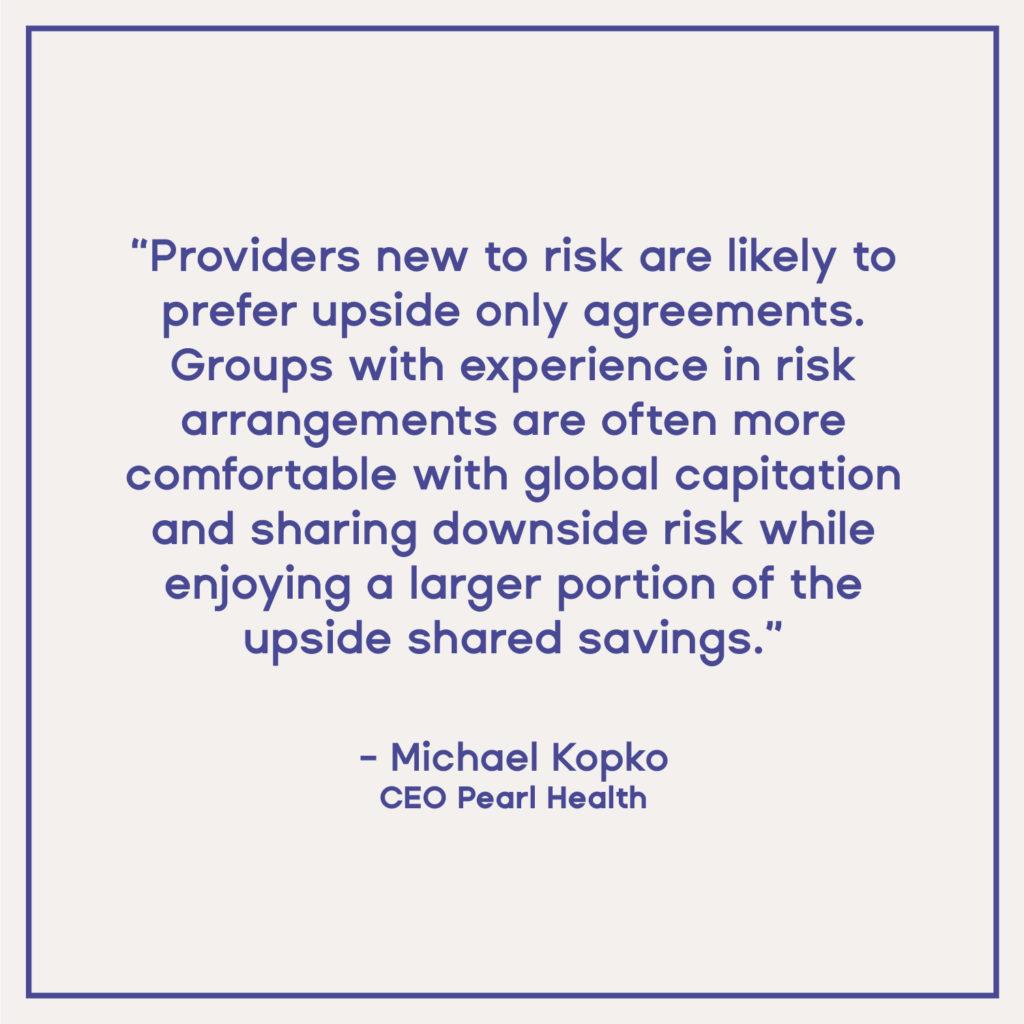For many providers, the permutations of program tracks and risk models in Medicare’s new Direct Contracting model can be overwhelming. First, it is critical to understand the value-based foundation of the program: rather than receiving fee-for-service reimbursement, providers are rewarded based on patient outcomes. These models ensure that providers have skin in the game and share in the risks of patient care. In other words, the Direct Contracting model options all incentivize providers to invest in their own efforts and their patients’ health. But different levels of risk are available when entering into a Direct Contracting participating provider agreement.
Intelligent decision making around which risk tracks and model options best suit your practice (and therefore which Direct Contracting Entity (DCE) to partner with) requires both knowledge and understanding of how the Direct Contracting risk options work. Based on historical trends and benchmarks, entities receive monthly payments based on a capitated rate. If their costs for care over time are less than these benchmarks, then they share in the cost savings. If they assume a higher degree of risk, they will enjoy a higher percentage of these shared savings. However, if their costs exceed benchmarks, they may be at risk for lower payments. And if they also accepted downside risk in their contracts, they may actually owe funds back to Medicare.
Knowing Direct Contracting Risk Options
When it comes to Direct Contracting models, there are two primary risk options. The first — the ‘professional’ option — allows DCEs and their participating providers to share 50% of any savings generated in a given performance year, with the other 50% being retained by CMS. DCEs are also responsible for repaying 50% of losses to CMS, should the DCE participating providers collectively underperform that year’s benchmark. The second option is a ‘global’ risk model where DCEs and their participating providers share 100% of any savings, and are responsible for 100% of losses. The global option carries greater risk and therefore demands that DCEs have greater experience.
Direct Contracting Entities choose between these options when entering into a Participation Agreement with Medicare, and all Participating Providers that join a given DCE must participate in the same risk track as the DCE.
Upside Only Versus Upside-Downside Contracts
Some DCEs offer different levels of risk as well. Entities must choose between a professional or global option in terms of their direct contracting risk contract, but they may then negotiate with individual providers to come to mutually-agreeable financial constructs. For example, DCEs may offer a provider an upside-only risk contract without any risk of losing funds, thereby assuming all downside risk, releasing the provider from any obligation to repay losses. In this case, the provider receives a portion of the shared savings if quality care is provided, but generally allocates a larger share of savings to the DCE, in acknowledgment for the downside exposure the DCE is accepting. Alternatively, DCEs may also offer a contract that passes through both upside and downside risk. In this case, providers would also be at risk for any shared losses experienced in a given performance year.
When considering upside and downside risks, providers and DCEs should analyze historical performance to inform responsible risk tolerances, as well as considering their own historical value-based care program experience and performance. For instance, providers with experience in similar models may be wise to consider upside/downside risk arrangements so that they can participate in a higher proportion of shared savings. For providers, the level of risk with which they are comfortable will determine if a direct contracting risk contract is appealing.
Determining Which Direct Contracting Risk Models Are Best
Beyond global and professional risk tracks, there are three classes of Direct Contracting Entities, each of which may participate in either risk track. ‘Standard’ Direct Contracting Entities are those with more experience in participating in value-based care programs (e.g. ACO participation) and that have substantial anticipated beneficiary alignment. This category represents the majority of DCEs currently participating. In contrast, ‘New Entrant’ DCEs will have limited experience in other models and lower beneficiary counts. ‘High Needs’ DCEs are designed for groups that care for patients with complex needs.
Tailoring a Direct Contracting Risk Contract to Meet Needs
The options available to DCEs are predefined by the Center for Medicare and Medicaid Services and established in the DCEs Participation Agreement with CMS. But negotiations between DCEs and their participant and preferred providers may feature greater flexibility, depending on the DCE in question. For example, providers may be offered a direct contracting risk contract with a 25% upside risk only. They receive a lower portion of shared savings, but at the same time, have less risk. This allows them to better tailor these value-based healthcare strategies to meet their own preferences. Knowing this, and having a basic understanding of Direct Contracting risk models, lets providers better position themselves for success.



